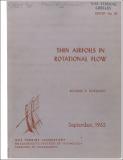| dc.contributor.author | Kotansky, Donald Richard | en_US |
| dc.contributor.other | General Electric Company | en_US |
| dc.contributor.other | General Motors Corporation. Allison Division | en_US |
| dc.contributor.other | Massachusetts Institute of Technology. Gas Turbine Laboratory | en_US |
| dc.date.accessioned | 2016-10-06T21:21:54Z | |
| dc.date.available | 2016-10-06T21:21:54Z | |
| dc.date.issued | 1965 | en_US |
| dc.identifier.uri | http://hdl.handle.net/1721.1/104678 | |
| dc.description | September 1965 | en_US |
| dc.description | Also issued as: Massachusetts Institute of Technology. Dept. of Mechanical Engineering. Thesis. 1966. Sc.D | en_US |
| dc.description | Includes bibliographical references (leaves 88-90) | en_US |
| dc.description.abstract | The problem of rotational or shear flow about thin airfoils has been investigated theoretically and experimentally. The theoretical approach is based on the concept of a lifting line in a bounded shear flow whose primary flow velocity profile may be expressed in terms of elementary linear, hyperbolic, and / or circular functions. The solution of the linearized equations of motion is reduced to the solution of a characteristic value problem whose form is dependent on the geometry of the primary flow. The characteristic value problem is solved for four different velocity profiles including that of a monotonic-matched linear profile ( a layer of constant vorticity fluid bounded by layers of uniform flow ) which serves as a model for the experimental shear flows. The experimental work includes the measurement of local lift coefficients and spanwise lift distributions on thin symmetrical airfoils in monotonic shear flows for three values of the ratio of airfoil chord to shear layer thickness. The results of the lifting line theory show good agreement with the experimental data within the range of applicability, i.e. within the linear region of the CL, a relationship and for flow geometries where the distortion ( spanwise convection ) of the surfaces of constant stagnation pressure is negligible. The assumption that the local lift coefficient is a function only of the local angle of attack and the two-dimensional characteristic of the airfoil section ( a fundamental assumption of lifting line theory ) is investigated experimentally through a consideration of local pressure coefficient distributions. An approximate correction to the lifting line theory is suggested for flows in which the distortion of surfaces of constant stagnation pressure cannot be neglected. | en_US |
| dc.description.sponsorship | Under the sponsorship of General Electric Company, Allison Division of General Motors Corporation | en_US |
| dc.format.extent | 1 volume (various pagings) | en_US |
| dc.publisher | Cambridge, Mass : Massachusetts Institute of Technology, [1965] | en_US |
| dc.relation.ispartofseries | GTL report #80 | en_US |
| dc.subject.lcc | TJ267.A1 M37 no.80 | en_US |
| dc.subject.lcc | TL574.A4 K68 1965 | en_US |
| dc.subject.lcsh | Aerofoils | en_US |
| dc.subject.lcsh | Lift (Aerodynamics) | en_US |
| dc.subject.lcsh | Boundary value problems | en_US |
| dc.title | Thin airfoils in rotational flow | en_US |
| dc.type | Technical Report | en_US |
| dc.identifier.oclc | 09165350 | en_US |
